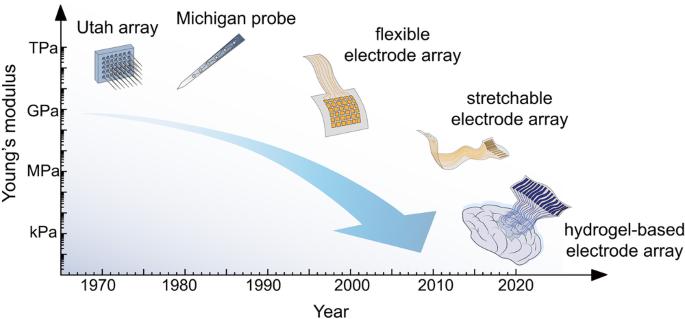用于下一代神经接口的水凝胶
IF 7.5
Q1 MATERIALS SCIENCE, MULTIDISCIPLINARY
引用次数: 0
摘要
克服植入式神经电极与生物组织之间的机械差异对于减轻免疫反应、减少剪切运动和确保持久功能至关重要。新出现的水凝胶神经接口具有体积电容、可定制的导电性和模拟组织的机械特性,与刚性接口相比,水凝胶神经接口是一种效率更高、危害更小、长期稳定的替代品。在此,我们将概述水凝胶在开发新一代神经界面方面的独特优势,并重点介绍正在改变这一领域的最新进展。我们需要能与神经元形成稳定界面的材料,而软材料在这方面最有前途。本文将讨论使用水凝胶(尤其是导电水凝胶)开发神经界面的优势和挑战。本文章由计算机程序翻译,如有差异,请以英文原文为准。

Hydrogels for next generation neural interfaces
Overcoming the mechanical disparities between implantable neural electrodes and biological tissue is crucial in mitigating immune responses, reducing shear motion, and ensuring durable functionality. Emerging hydrogel-based neural interfaces, with their volumetric capacitance, customizable conductivity, and tissue-mimicking mechanical properties, offer a more efficient, less detrimental, and chronically stable alternative to their rigid counterparts. Here, we provide an overview of the exceptional advantages of hydrogels for the development of next-generation neural interfaces and highlight recent advancements that are transforming the field. Materials are needed that can form stable interfaces with neurons, and soft materials are the most promising for this. Here, the advantages and challenges associated with neural interfaces using hydrogels, particularly conductive hydrogels, are discussed.
求助全文
通过发布文献求助,成功后即可免费获取论文全文。
去求助
来源期刊

Communications Materials
MATERIALS SCIENCE, MULTIDISCIPLINARY-
CiteScore
12.10
自引率
1.30%
发文量
85
审稿时长
17 weeks
期刊介绍:
Communications Materials, a selective open access journal within Nature Portfolio, is dedicated to publishing top-tier research, reviews, and commentary across all facets of materials science. The journal showcases significant advancements in specialized research areas, encompassing both fundamental and applied studies. Serving as an open access option for materials sciences, Communications Materials applies less stringent criteria for impact and significance compared to Nature-branded journals, including Nature Communications.
 求助内容:
求助内容: 应助结果提醒方式:
应助结果提醒方式:


